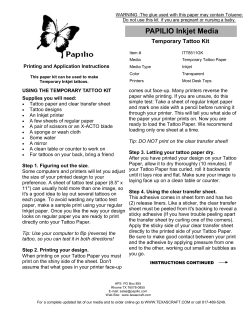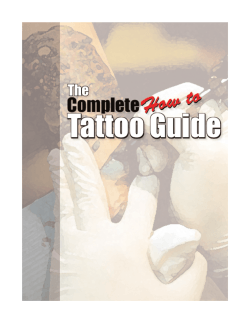
Document 26081
DIVISION OF AGRICULTURE RESEARCH & EXTENSION Agriculture and Natural Resources University of Arkansas System FSA4015 Tattooing of Cattle and Goats The proper identification of Steven M. Jones Associate Professor Animal Science identification. Identification within animals is essential for all aspects of the dairy or beef herd requires efficient livestock production. It allows visibility and is most commonly for the orderly proof and transfer of accomplished using permanent ear ownership and becomes more impor tags. These are also used for goats. tant as herds increase in size. Unique Generally, smaller ear tags are identification is required if the owner preferred for goats rather than the wishes to register purebred animals larger cattle ear tags. Non-permanent with breed registries or exhibit them identification includes paint, chalk at most livestock shows. Proper and stick-on tags. identification enables the producer to keep comprehensive records of Tattooing is one method of milk production, reproduction, health identification that is permanent if problems and management practices. properly done. However, it is not The efficient maintenance of this easily viewed and may require another information requires a permanent complementary method of identifica identification system. tion, such as an ear tag, that is visible from short distances. This publication Several systems of identification primarily addresses tattooing of dairy may be used. The system selected will cattle, beef cattle and goats but is depend upon the size of the herd, the applicable to other animals. environmental conditions under which they are maintained, the primary Tattooing requires a pair of pliers purpose for identifying individual ani and numbers or letters made of sharp, mals, rules and regulations of breed- needlelike projections which pierce governing bodies or shows you attend the skin. The tattoo ink is forced into and equipment that is available. the punctures and remains visible after the puncture wounds heal. Arkansas Is Our Campus There are two basic types of Tattooing is usually done on the ears, identification: permanent and and tattoos can be seen best on ani non-permanent. Breed associations mals that have white ears. Those and most shows require permanent with black pigment in the ears can be Visit our web site at: http://www.uaex.edu University of Arkansas, United States Department of Agriculture, and County Governments Cooperating tattooed, but the numerals and letters are more difficult to read. La Mancha goats lack large external ears, so they are tattooed on the tail web. On dark-pigmented ears of cattle or goats (for example, Alpine goats), use green or white ink instead of black. Many brands of indelible ink are available through your livestock supply house, local livestock store or cooperative. The roll-on applicators, rather than the paste, have been proven to save ink and make the job cleaner (Figure 1). Remember to use a non-black ink on a dark ear. Figure 2 – Gathering materials is the first step in getting ready to tattoo. measures to decrease spread of disease include wear ing gloves, using separate cloths or pads to clean animals’ ears and disinfecting equipment between animals. First, gather the necessary materials (Figure 2): Figure 1 – Two varieties of ink available are the roll-on (top) and the paste (bottom). The roll-on variety is most commonly used. Restraint Required The restraint of animals for tattooing will vary • Gloves • Halter • Alcohol pads or rubbing alcohol and a soft, clean cloth • Spray bottle of rubbing alcohol • Tattoo ink • Tattoo kit Consider the purchase of a small animal tattoo with the age and strength of the animal but requires kit with 5/16" digits (compared to the normal size of that the ears be stable with little movement. A small, 3/8") and tattooing at less than two weeks of age. The young animal can be held in the arms of an assistant. animals are easier to restrain, the smaller numbers Older animals should be placed in a stanchion or are easier to insert in the ear and the tattoo will grow chute. Young goats are often placed in a box that holds with the animal. Rotary tattoo kits also are available. kids for disbudding. Be sure to maintain tattooing equipment, keeping Getting Started it clean and replacing broken or dull characters (letters and numbers). A buildup of dirt or broken Biosecurity protocol should be followed by working in an environment that is as clean as possible. Other and/or dull equipment can result in improper or illegible tattoos. Tattooing Procedures Step 1. Clean Ear with Alcohol Using an alcohol pad, clean out the ear completely (Figure 3). Wax interferes with the permanency of the ink; if wax is mixed with the ink, the tattoo will most likely fade. Hair can also interfere with a proper tattoo, so the ears may need to be clipped. If no alcohol pads are available, rubbing alcohol and a soft, clean cloth or cotton swab also will work as long as the wax is completely removed. Water is normally not used to clean the ears as it can get in the ear canal Figure 4 – Apply ink between the first and second ribs. The ink should thoroughly cover the skin. and may cause an ear infection. A damp cloth can be used, but it is less sanitary than alcohol. Be sure the Step 3. Tattooing tattoo does not interfere with a present or future Brucellosis tattoo for cattle. Hold the animal securely. After verifying the correct tattoo by punching it into a piece of paper, position the tongs in the center of the ear between the ribs of cartilage and squeeze firmly (Figure 5). Avoiding the ribs will prevent bleeding. Be sure to lift the tongs out straight; many tattoos have been ruined by scratches. If you must repeat the process, tattoo in the exact same place as previously to avoid overlapping numeral/numbers. This will cause the tattoo to be indistinguishable. Figure 3 – A clean ear is the first step to a successful tattoo. Clipping ears may also be necessary to avoid interference from hair. Step 2. Applying Ink Apply a generous amount of ink over the area to be tattooed, usually between the middle ribs of the ear (Figure 4). Keep away from the hair around the edge of the ear. An area slightly larger than the tattoo equipment should be covered. Remember to use a non-black ink on a dark ear. Figure 5 – Keep a firm grip on the calf or kid to avoid any movement that could cause the tongs to slip. Step 4. Reapplying Ink Step 6. The Finished Product Again, apply ink and rub in firmly. This single After several weeks, the ink will dry and flake out step will assure a lasting tattoo if you have followed of the ear, leaving a legible tattoo and a permanent the above procedure. An old toothbrush may be used means of identification (Figure 7). A note of caution – to help push the ink into the punctures. remind your veterinarian there is a tattoo in that ear and that it should be avoided if a vaccination tattoo is inserted. Step 5. Sanitizing Equipment Sanitize the tattoo kit between animals by spraying rubbing alcohol on the tongs and the indi vidual tattoo pieces that have been used (Figure 6). This cleaning will minimize infection in the tattoo and should be done before and after each procedure. Figure 7 – After several weeks, the tattoo should become legible as the dried ink flakes out of the calfʼs or kidʼs ear. Figure 6 – Sanitizing tattooing equipment is just one way to follow biosecurity protocol. Parts of this publication were taken from “Tattooing 101: Reviewing the Basics of Identifying Calves,” Jersey Journal, October, 2001, pages 27-28, and were used with permission of the American Jersey Cattle Association. Printed by University of Arkansas Cooperative Extension Service Printing Services. STEVEN M. JONES is associate professor - animal science with the Department of Animal Science at the University of Arkansas Division of Agriculture in Little Rock. FSA4015-PD-3-2014RV Issued in furtherance of Cooperative Extension work, Acts of May 8 and June 30, 1914, in cooperation with the U.S. Department of Agriculture, Director, Cooperative Extension Service, University of Arkansas. The Arkansas Cooperative Extension Service offers its programs to all eligible persons regardless of race, color, national origin, religion, gender, age, disability, marital or veteran status, or any other legally protected status, and is an Affirmative Action/Equal Opportunity Employer.
© Copyright 2025





















